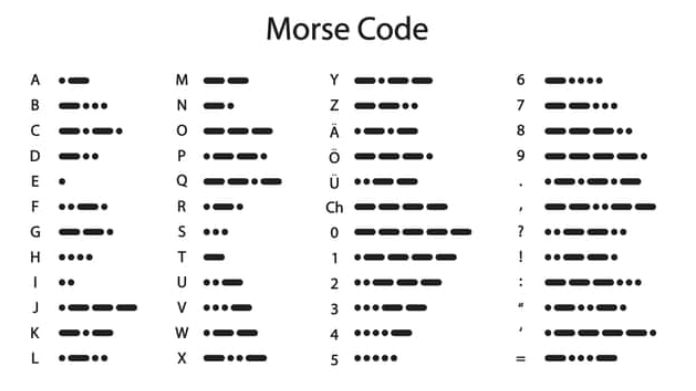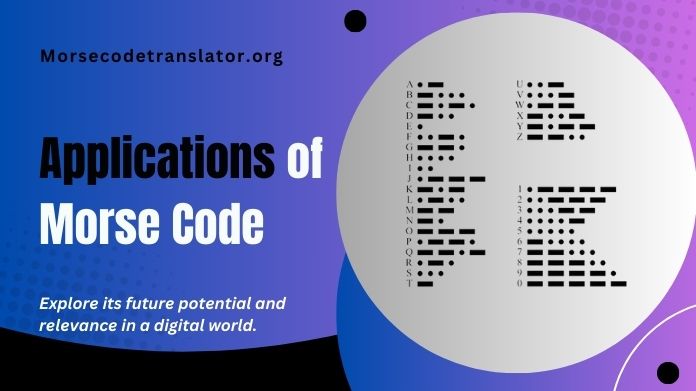In an age dominated by cutting-edge technology, Morse code, a communication system developed over 180 years ago, is a testament to the enduring power of simplicity and efficiency. Initially employed for telegraphy, Morse code has evolved far beyond its initial applications of Morse code.
Today, we embark on a journey to explore the future of Morse code, uncovering its contemporary applications of Morse code that stretch across various domains.
From emergency communication in remote areas to innovative uses in assistive technology, Morse code continues to adapt, proving its relevance and resilience in our ever-changing world.
Join Morse Code Translator as we delve into the diverse and promising applications that pave the way for Morse code’s enduring legacy in the digital era.
What is Morse Code?

Morse Code is a form of communication that uses a series of dots and dashes to represent letters and numbers. Samuel Morse and Alfred Vail developed it in the early 1830s using telegraph systems to send messages over long distances.
Each letter and number in the English alphabet is represented by a unique combination of dots and dashes, transmitted as electrical signals or flashes of light.
Morse Code was widely used for telegraph communication until the development of more advanced technology. However, it is still occasionally used today in radio communication and to transmit distress signals.
Morse Code in Modern-Day
Morse code has found renewed relevance and applications across various domains in the modern era, showcasing its adaptability and timelessness.
Here are some notable modern-day applications of Morse code:
1. Emergency Signaling: Morse code remains a crucial tool for emergency signaling, especially in situations where other forms of communication may fail. Flashing lights, sounds, or visual signals can transmit Morse code, providing a universal means of distress communication.
2. Aviation and Maritime Communication: Morse code is still employed in aviation and maritime industries for radio communication. Coded messages are concise and can be transmitted more reliably than voice communication in certain conditions, making Morse code a valuable backup in critical situations.
3. Assistive Technology: Morse code has been embraced in assistive technology, empowering individuals with disabilities. Devices like sip-and-puff systems or eye-tracking technology can use Morse code as an input method, enabling users to communicate and control devices more effectively.
4. Educational Tool: Morse code is an educational tool that teaches students about communication, history, and technology. Its simplicity makes it an accessible and engaging entry point for learning about coding and encryption.
5. Cryptographic Applications: Morse code can be integrated into cryptographic systems for secure communication. Individuals can add an extra layer of encryption to their communications by converting messages into Morse code.
6. Games and Puzzles: Morse code has found its way into various games, puzzles, and escape rooms, adding an element of challenge and intrigue. Its use in entertainment showcases the enduring fascination with this historic communication system.
7. Mobile Applications: Morse code has been incorporated into mobile applications for practical and recreational purposes. Some apps translate text messages into Morse code, offering a unique and customizable communication method.
8. Experimental Technologies: Researchers and hobbyists continue to explore experimental technologies that involve Morse code. This includes projects using light signals, vibrations, or other unconventional methods for Morse code communication.
9. Historical Preservation: Morse code is preserved and celebrated as part of our cultural and technological heritage. Museums, historical societies, and amateur radio enthusiasts keep the tradition alive through exhibitions, events, and on-air demonstrations.
Applications of Morse Code

Morse code, with its simplicity and efficiency, has found applications across various domains. Here are notable applications of Morse code:
1. Telecommunication: Morse code’s primary historical application was in telegraphy, allowing messages to be transmitted over long distances using telegraph lines. It played a crucial role in early communication and the development of the telegraph.
2. Aviation and Maritime Communication: Morse code is still used for radio communication in aviation and maritime industries. Pilots, air traffic controllers, and maritime operators may use Morse code for specific messages, providing a reliable and standardized communication method.
3. Emergency Signaling: Morse code is employed for emergency signaling using light signals, sound signals, or other visual methods. This includes using flashlights, signal lamps, or flags to convey distress signals.
4. Military Communication: Morse code has historical significance in military communication. It was extensively used during wars for encoding and decoding messages. While modern military communication relies on advanced technology, Morse code is still part of training for certain situations.
5. Assistive Technology: Morse code is utilized in assistive technology for individuals with disabilities. It can be implemented in devices that enable communication through eye blinks, muscle twitches, or other controlled movements.
6. Educational Tool: Morse code is an educational tool to teach coding, communication, and problem-solving. It provides a hands-on experience and a historical perspective on the evolution of communication technology.
7. Amateur Radio (Ham Radio): Morse code proficiency was a requirement for amateur radio operators for many years. While no longer mandatory, Morse code is still popular among amateur radio enthusiasts, and many engage in Morse code conversations.
8. Cryptography and Encryption: Morse code can be incorporated into cryptographic systems for encoding and decoding secret messages. Its simplicity and historical context make it an exciting element in encryption methods.
9. Recreational and Cultural Events: Morse code is used in various recreational events, competitions, and cultural celebrations. Morse code contests challenge enthusiasts, and some events feature on-air demonstrations of its use.
10. Mobile Applications and Games: Morse code has found its way into mobile applications, offering users a unique way to learn and practice the code. It is also incorporated into games and puzzles, adding an entertaining and educational element.
The enduring legacy of Morse code is evident in its continued applications, from traditional telecommunication to innovative uses in technology, education, and beyond.
Wrapping Up!
In wrapping up our look at applications of Morse code, it’s clear that this old communication style is going nowhere. We’ve seen it go from telegraphs to helping pilots communicate and even assisting people with disabilities.
Despite all our high-tech stuff, Morse code still has a place, whether in fun contests, as an educational tool, or as a backup in emergencies.
And who knows? In the future, we might find even more cool ways to use Morse code. Its simplicity and reliability make it a timeless tool, connecting the past with the present and keeping us curious about what’s next.
